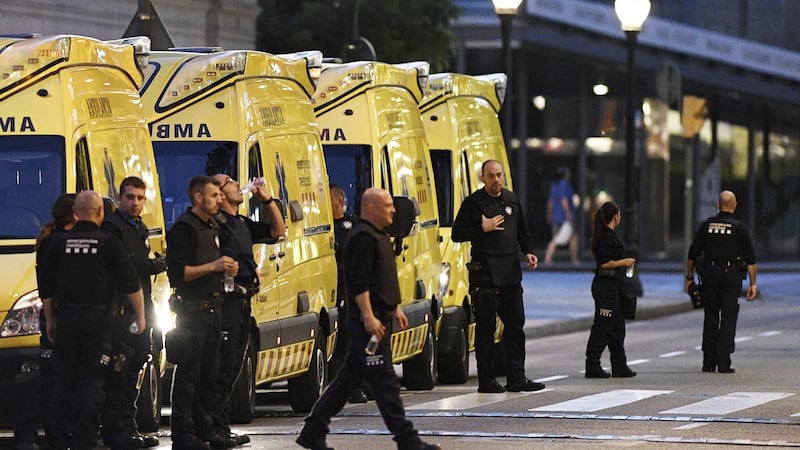The terrorist attack in Barcelona underlines three harsh lessons learned by security services – and the general public – over recent months and years.
The first is that the use of vehicles as weapons is now an established tactic by extremists, one of the dozen or so employed in the last two decades that should be considered a standard part of the terrorist arsenal. In the last 13 months there have been similar attacks in France, Germany, Sweden and the UK.
A woman was killed by a car driven at speed by a right-wing extremist in the US last week in slightly different circumstances.
The precise motivation and the identity of the Barcelona attackers will become clear in the next few hours. So far there has been no claims of responsibility from Islamic State, also known as Isis. These can take between eight and 48 hours, if they come at all. In recent months, such claims have become highly unreliable. Individuals close to Isis and active on social media have been celebrating the Barcelona attack, but this does not indicate a connection to the group.
Tactics spread among militants when they are seen to work. There is no skill needed to drive a vehicle into a crowd, nor any difficulty involved in obtaining one. This makes a car, van or lorry an ideal weapon for today’s terrorists, who are often inspired by a group but are not actually part of it, and for the most part, lack the training and means necessary for more complex attacks.
The second lesson is that there is now little discrimination in targeting. This means tourists are very much in the line of fire. A decade or so ago, Islamic militant groups sought to send specific messages through their violence. Random attacks against unarmed civilians were seen as ineffective, and even counter-productive in terms of public opinion in the Muslim world. The 9/11 attack was launched against targets seen by al-Qaeda as symbols of US economic, political and military power.
In 2004, Spain was the target of the bloodiest jihadi attack on European soil when commuter trains were bombed by al-Qaeda sympathisers in Madrid. One aim was to undermine Spanish support for military intervention in Iraq, and influence an election. Spain was also a particular target because of the historic resonance for militants of the Islamic kingdom of Andalusia, lost to Christendom 900 years ago.
Anyone, anywhere, anyhow
This has changed. Isis has led a broader shift towards attacking anyone, anywhere, anyhow. Public spaces, always inherently vulnerable, are now more at risk than ever. Music fans in Manchester, summer revellers in Nice, pub goers in London, and of course tourists, whether taking pictures on Westminster bridge, on a beach in Tunisia, or on an aircraft returning to Russia from Egypt.
Western holidaymakers overseas were targeted long ago. In 1997 there was a bloody attack in Luxor by Egyptian militants. But tourists were never a principle focus of violence. Now, they appear to be. Anyone driving a van onto the pavement on Las Ramblas, one of the most crowded tourist zones in the world, was trying to kill foreign travellers. Spanish authorities were aware of the threat, and at Christmas sought to reinforce the protection of public spaces.
One plot to use a truck against pedestrians was thwarted in November. Bollards, concrete blocks and other defences were considered. Intelligence gathering was stepped up.

But there is little that can be done in a hugely popular Mediterranean port city to guard against such an attack, and the third lesson is that good policing can keep you safe only so long.
Ill-equipped
French intelligence services, in part due to their experience of fighting Islamic militancy in the 1990s, were well ahead of their UK or US counterparts for a decade or so. But by 2012, French spooks, under-resourced and undermined by poor national and Europe-wide intelligence sharing, were struggling to contain the threat. They were ill-equipped to face the offensive launched in 2014 by Isis against their country from its newly won enclaves in Syria and Iraq.
The same may be true for Spanish services, which are much admired for their professionalism in the counter-terrorism world. The Spanish invested massively in intelligence agencies after the 2004 attacks, building up a formidable capability for gathering information and acting on it. This has kept Spain safe from Islamic militant terrorism for 13 years. Major plots were broken up in 2008. Last year Spain foiled at least 10 separate conspiracies.
This year two more networks have been uncovered, including at least one with connections to Isis-led attackers elsewhere in Europe. As Britons have discovered this year, just because there are no successful attacks does not mean there’s no Islamic militancy. So the final harsh lesson is that something, or someone, will get through eventually.
Guardian service










